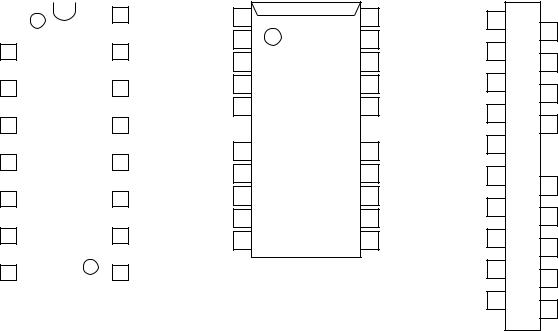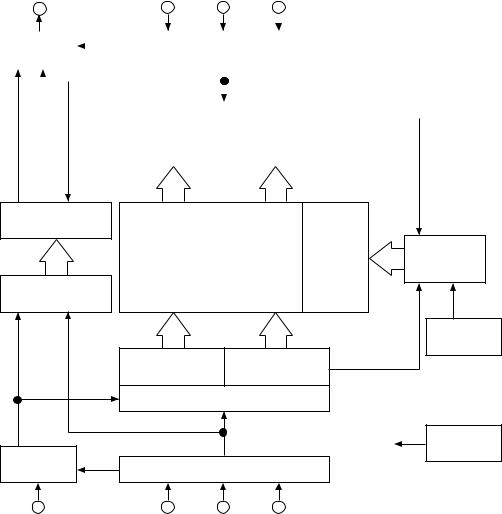OKI MSM514222B-60RS, MSM514222B-30ZS, MSM514222B-40JS, MSM514222B-40RS, MSM514222B-40ZS Datasheet
...
E2L0030-17-Y1
This version: Jan. 1998
¡SemiconductorSemiconductor MSM514222B
Previous version: Dec. 1996
MSM514222B
262,263-Word ´ 4-Bit Field Memory
DESCRIRTION
The OKI MSM514222B is a high performance 1-Mbit, 256K ´ 4-bit, Field Memory. It is designed for high-speed serial access applications such as HDTVs, conventional NTSC TVs, VTRs, digital movies and Multi-media systems. It is a FRAM for wide or low end use as general commodity TVs and VTRs, exclusively. The MSM514222B is not designed for the other use or high end use in medical systems, professional graphics systems which require long term picture, and data storage systems and others. The 1-Mbit capacity fits one field of a conventional NTSC TV screen and cascaded directly without any delay devices among the MSM514222B. (Cascading of MSM514222B provides larger storage depth or a longer delay).
Each of the 4-bit planes has separate serial write and read ports. These employ independent control clocks to support asynchronous read and write operations. Different clock rates are also supported that allow alternate data rates between write and read data streams.
The MSM514222B provides high speed FIFO, First-In First-Out, operation without external refreshing: it refreshes its DRAM storage cells automatically, so that it appears fully static to the users.
Moreover, fully static type memory cells and decoders for serial access enable refresh free serial access operation, so that the serial read and/or write control clock can be halted high or low for any duration as long as the power is on. Internal conflicts of memory access and refreshing operations are prevented by special arbitration logic.
The MSM514222B's function is simple, and similar to a digital delay device whose delay-bit- length is easily set by reset timing. The delay length, number of read delay clocks between write and read, is determined by externally controlled write and read reset timings.
Additional SRAM serial registers, or line buffers for the initial access of 256 ´ 4-bit enable high speed first-bit-access with no clock delay just after the write or read reset timings.
The MSM514222B is similar in operation and functionality to OKI 2-Mbit Field Memory MSM518222.
1/15
¡ Semiconductor |
MSM514222B |
FEATURES
•Single power supply: 5 V ±10%
•512 Rows ´ 512 Column ´ 4 bits
•Fast FIFO (First-in First-out) operation
•High speed asynchronous serial access
Read/Write cycle time |
30 ns/40 ns/60 ns |
Access time |
25 ns/30 ns/50 ns |
•Functional compatibility with OKI MSM518222
•Self refresh (No refresh control is required)
•Package options:
16-pin 300 mil plastic DIP |
(DIP16-P-300-2.54-W1) |
(Product : MSM514222B-xxRS) |
26/20-pin 300 mil plastic SOJ (SOJ26/20-P-300-1.27) |
(Product : MSM514222B-xxJS) |
|
20-pin 400 mil plastic ZIP |
(ZIP20-P-400-1.27) |
(Product : MSM514222B-xxZS) |
|
|
xx indicates speed rank. |
PRODUCT FAMILY
Family |
Access Time (Max.) |
Cycle Time (Min.) |
Package |
|
|
|
|
MSM514222B-30RS |
25 ns |
30 ns |
|
|
|
|
|
MSM514222B-40RS |
30 ns |
40 ns |
300 mil 16-pin DIP |
|
|
|
|
MSM514222B-60RS |
50 ns |
60 ns |
|
|
|
|
|
MSM514222B-30JS |
25 ns |
30 ns |
|
|
|
|
|
MSM514222B-40JS |
30 ns |
40 ns |
300 mil 26/20-pin SOJ |
|
|
|
|
MSM514222B-60JS |
50 ns |
60 ns |
|
|
|
|
|
MSM514222B-30ZS |
25 ns |
30 ns |
|
|
|
|
|
MSM514222B-40ZS |
30 ns |
40 ns |
400 mil 20-pin ZIP |
|
|
|
|
MSM514222B-60ZS |
50 ns |
60 ns |
|
|
|
|
|
2/15

¡ Semiconductor |
MSM514222B |
PIN CONFIGURATION (TOP VIEW)
WE |
|
|
|
16 |
VCC |
1 |
|
|
|||
RSTW |
2 |
|
|
15 |
RE |
SWCK |
3 |
|
|
14 |
RSTR |
DIN0 |
4 |
|
|
13 |
SRCK |
DIN1 |
5 |
|
|
12 |
DOUT0 |
DIN2 |
6 |
|
|
11 |
DOUT1 |
DIN3 |
7 |
|
|
10 |
DOUT2 |
VSS |
8 |
|
|
9 |
DOUT3 |
|
|
16-Pin Plastic DIP |
|
||
WE |
1 |
26 |
VCC |
SRCK |
1 |
|
RSTW |
2 |
25 |
RE |
RE |
3 |
|
SWCK |
3 |
24 |
RSTR |
|||
|
|
|||||
DIN0 |
4 |
23 |
SRCK |
WE |
5 |
|
NC |
5 |
22 |
NC |
SWCK |
7 |
|
|
|
|
|
|||
NC |
9 |
18 |
NC |
NC |
9 |
|
|
|
|||||
DIN1 10 |
17 |
DOUT0 |
NC |
11 |
||
DIN2 11 |
16 |
DOUT1 |
DIN1 |
13 |
||
DIN3 12 |
15 |
DOUT2 |
||||
|
|
|||||
VSS 13 |
14 |
DOUT3 |
DIN3 |
15 |
||
|
|
|
|
DOUT3 |
17 |
|
26/20-Pin Plastic SOJ
DOUT1 19
2 RSTR
4 VCC
6 RSTW
8 DIN0
NO LEAD 12 NC
14 DIN2
16 VSS
18 DOUT2
20 DOUT0
20-Pin Plastic ZIP
Pin Name |
Function |
|
|
SWCK |
Serial Write Clock |
|
|
SRCK |
Serial Read Clock |
|
|
WE |
Write Enable |
|
|
RE |
Read Enable |
|
|
RSTW |
Write Reset Clock |
|
|
RSTR |
Read Reset Clock |
|
|
DIN0 - 3 |
Data Input |
DOUT0 - 3 |
Data Output |
VCC |
Power Supply (5 V) |
VSS |
Ground (0 V) |
NC |
No Connection |
|
|
3/15

¡ Semiconductor |
MSM514222B |
BLOCK DIAGRAM
DOUT (´ 4) |
RE |
RSTR SRCK |
|
||||||
|
|
|
|
|
|
|
|
|
|
|
|
|
|
|
|
|
|
|
|
Data-Out |
|
|
Serial |
Read |
Controller |
|
|||
|
|
||||||||
Buffer (´ 4) |
|
|
|
|
|
|
|||
|
|
|
|
|
|||||
|
|
|
|
|
|
|
|
|
|
|
|
|
|
|
|
|
|
|
|
|
|
|
|
|
|
|
|
|
|
|
|
|
|
|
512 Word Serial Read Register (´ 4) |
|
|||
|
|
|
|
|
|
||||
|
|
|
|
|
|
||||
|
|
|
|
|
|
|
|
|
|
|
|
|
|
|
Read Line Buffer |
Read Line Buffer |
|
||
|
|
|
|
|
Low-Half (´ 4) |
High-Half (´ 4) |
|
||
|
|
256 (´ 4) |
256 (´ 4) |
|
|
120 Word |
|
|
|
|
|
Sub-Register (´ 4) |
|
256K (´ 4) |
|
|
|
|
|
X |
Read/Write |
||
|
|
Memory |
|||
|
|
Decoder |
and Refresh |
||
|
|
Array |
|
Controller |
|
120 Word |
|
|
|
||
|
|
|
|
|
|
Sub-Register (´ 4) |
|
|
|
|
|
|
|
256 (´ 4) |
256 (´ 4) |
Clock |
|
|
Write Line Buffer |
Write Line Buffer |
Oscillator |
||
|
|
||||
|
Low-Half (´ 4) |
High-Half (´ 4) |
|
||
|
512 Word Serial Write Register (´ 4) |
|
|||
|
|
|
|
|
VBB |
Data-In |
|
|
|
|
Generator |
Serial |
Write |
|
Controller |
|
|
Buffer (´ 4) |
|
|
|||
DIN (´ 4) |
WE |
RSTW |
SWCK |
|
|
4/15
¡ Semiconductor |
MSM514222B |
OPERATION
Write Operation
The write operation is controlled by three clocks, SWCK, RSTW, and WE. Write operation is accomplished by cycling SWCK, and holding WE high after the write address pointer reset operation or RSTW.
Each write operation, which begins after RSTW, must contain at least 130 active write cycles, i.e. SWCK cycles while WE is high. To transfer the last data to the DRAM array, which at that time is stored in the serial data registers attached to the DRAM array, an RSTW operation is required after the last SWCK cycle.
Write Reset : RSTW
The first positive transition of SWCK after RSTW becomes high resets the write address counters to zero. RSTW setup and hold times are referenced to the rising edge of SWCK. Because the write reset function is solely controlled by the SWCK rising edge after the high level of RSTW, the states of WE are ignored in the write reset cycle.
Before RSTW may be brought high again for a further reset operation, it must be low for at least two SWCK cycles.
Data Inputs : DIN0 - 3
Write Clock : SWCK
The SWCK latches the input data on chip when WE is high, and also increments the internal write address pointer. Data-in setup time tDS, and hold time tDH are referenced to the rising edge of SWCK.
Write Enable : WE
WE is used for data write enable/disable control. WE high level enables the input, and WE low level disables the input and holds the internal write address pointer. There are no WE disable time (low) and WE enable time (high) restrictions, because the MSM514222B is in fully static operation as long as the power is on. Note that WE setup and hold times are referenced to the rising edge of SWCK.
5/15
